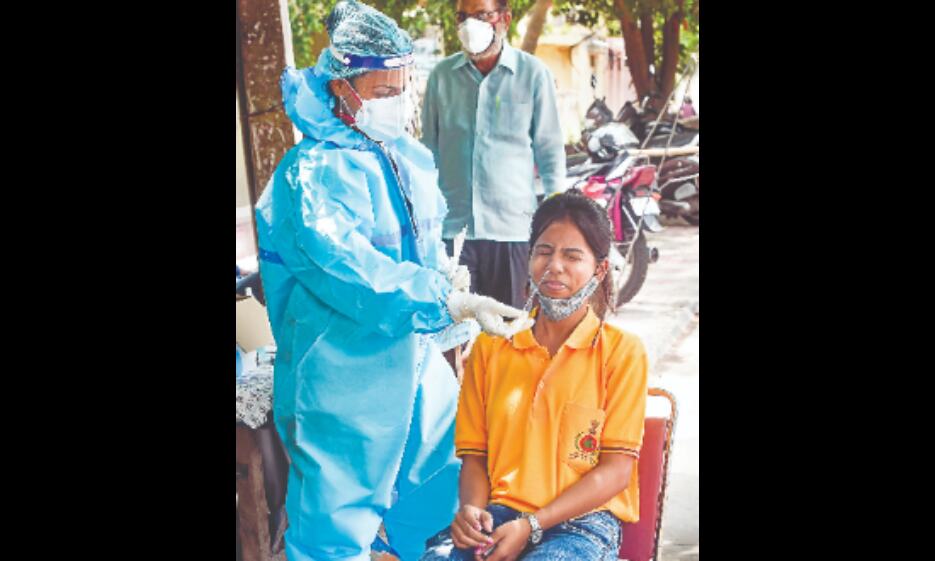'B.1.617 variant drove surge in Covid cases in last 2 months'

New Delhi: The surge of COVID-19 cases in the country in the last two months shows a correlation with the rise in B.1.617 variant of the SARS-CoV-2, according to INSACOG, a grouping of 10 national laboratories.
April and May witnessed a deadly second wave of Coronavirus cases that swept through the country, stretching the healthcare infrastructure to its limits.
According to INSACOG, the B.1.1.7 lineage of the virus, which was first identified in the United Kingdom is declining in proportion across India in the last one and half months. The B.1.1.7 variant of the Coronavirus has been named 'Alpha'.
The B.1.617 lineage of SARS CoV-2 was first reported from Maharashtra but it is now seen in other states such as West Bengal, Andhra Pradesh, Delhi, Gujarat, Telangana.
"The current surge in cases seen over the last two months in some states shows a correlation with the rise in the B.1.617 lineage of SARS CoV-2," the Indian SARS-CoV-2 Consortium on Genomics (INSACOG) said.
The B.1.617 lineage has further evolved into three sub lineages -- B.1.617.1, B.1.617.2 and B.1.617.3. Early data shows B.1.617.2, dubbed Delta by the WHO, has higher transmission advantages over the other two sub-lineages.
B.1.617, initially termed a double mutant, has three new spike protein mutations. Two mutations — E484Q and L452R — are in the area important for antibody-based neutralisation.
The third mutation — P681R in B.1.617 — along with the reversion of E484Q allows its sub-lineage to be more infectious.
It was found in high levels in genomes sequenced in Maharashtra (2,077), West Bengal (630), Delhi (1,458), Karnataka (225) as of May 28, and accumulates new mutations in spike and other genes, the INSACOG found in the genomes sequenced as of May 28.
The World Health Organisation (WHO) has termed it a 'Variant of Concern'.
B.1.617.1 and B.1.617.3 sub-lineages have two receptor binding domain mutations — L452R and E484Q. The former has seven spike mutations, while the latter has seven to eight.
In the case of B.1.617.2, it has nine to 10 spike mutations and two receptor binding domain mutations — L452R and T478K. B.1.6171.1 and B.1.617.2 have higher transmission rate and reduced susceptibility to neutralisation antibodies.
In the case of all the three sub-lineages, it has the potential to reduced antibody efficacy and potential reduced neutralisation by vaccine sera, which, however, remains to be established.
B.1.1.7, also known as the Alpha variant, has 50 per cent increased transmission. It also has increased severity.
The INSACOG is a grouping of 10 national laboratories that was established by the Ministry of Health and Family Welfare on December 25 last year.
According to research published in The Lancet journal, people fully vaccinated with the Pfizer-BioNTech vaccine are likely to have more than five times lower levels of neutralising antibodies against the Delta variant first identified in India compared to the original strain.
The study also shows that levels of these antibodies that can recognise and fight the virus are lower with increasing age, and that levels decline over time, providing additional evidence in support of plans to deliver a booster dose to vulnerable people.
India reported 1,32,364 new Coronavirus infections taking the country's total tally of COVID-19 cases to 2,85,74,350 out of which 2,65,97,655 people have recuperated from the disease as the recovery rate surged to 93.08 per cent, according to the Union Health Ministry data updated on Friday. Recoveries continue to outnumber daily new cases for 22 consecutive days.
The COVID-19 death toll climbed to 3,40,702 with 2,713 fresh deaths, while the active cases were recorded below 20 lakh for the fourth consecutive day, the data updated at 8 am showed.
A total of 20,75,428 tests were conducted on Thursday taking the total cumulative tests conducted so far for detection of COVID-19 in the country to 35,74,33,846.
The daily positivity was recorded at 6.38 per cent. It has been less than 10 per cent for 11 consecutive days, the ministry said, adding the weekly positivity rate has declined to 7.27 per cent.
The active cases have reduced to 16,35,993 comprising 5.73 per cent of the total infections, while the national COVID-19 recovery rate has improved to 93.08 per cent.
A net decline of 77,420 cases has been recorded in the COVID-19 caseload in a span of 24 hours while the case fatality rate stands at 1.19 per cent, the data stated.
Meanwhile, for the first time in Tamil Nadu, a lion has died of Coronavirus while nine others in the pride have tested positive for the infection at a zoo near here.
"It is for the first time that the big cats have tested positive for the virus in Tamil Nadu," a official said.
The nine-year-old 'Neela', a lioness, which was in the safari area, succumbed to the virus on Thursday while nine of the 11 in the park tested positive for COVID-19, said officials of the Arignar Anna Zoological Park at Vandalur.
The park, spread across 602 hectares at Vandalur about 35 kms from the city, had remained shut with the COVID-19 enforced lockdown.



